The ICD codes for mental health list is the most frequently-billed ICD-10 codes used to treat mental health issues diagnosed in 2022.
ICD, or International Classification of Diseases, codes are standardized codes used to classify and describe medical diagnoses and procedures. In the field of mental health, ICD codes are used to describe and classify various mental health conditions, including mood disorders, anxiety disorders, psychotic disorders, personality disorders, and substance use disorders.
It’s perhaps not surprising that the top-rated ICD-10 codes for mental health classification for anxiety within America was F41.1–generalized anxiety disorders. Below are a few codes to know:
Sort | Code | Diagnosis |
1 | F41.1 | Generalized anxiety disorder |
2 | F43.23 | Adjustment disorder that includes mixed anxiety and depression |
3 | F33.1 | Major depressive disorder, recurrent, moderate |
4 | F43.22 | Adjustment disorder and anxiety |
5 | F43.20 | Adjustment disorder, unspecified |
6 | F41.9 | Anxiety disorder, not specified |
7 | F43.10 | Post-traumatic stress disorder, not specified |
8 | F43.21 | Adjustment disorder accompanied by depression |
9 | F43.12 | Post-traumatic stress disorder chronic |
10 | Z63.0 | Trouble in the relationship with partner or spouse |
11 | F33.0 | Major depressive disorder, recurrent, mild |
12 | F90.2 | Attention-deficit hyperactivity disorder and its combined types |
13 | F32.1 | Major depressive disorder, single episode, moderate |
14 | F34.1 | Dysthymic disorder |
15 | F90.0 | Attention-deficit disorder, mostly the type of inattention |
16 | F33.2 | Major depression, recurrent, with no psychotic symptoms |
17 | F32.0 | Major depressive disorder, single episode, mild |
18 | F43.25 | Adjustment disorder that causes mixed emotional disturbance and behavior |
19 | F41.0 | Disorder of panic (episodic paroxysmal anxiety) |
20 | F84.0 | Autistic disorder |
Top Diagnoses Categories
To better understand the nature of the most prevalent mental health diagnoses during 2022, we looked at all 20 ICD codes mental health from 2022. We divided them into four corresponding categories as follows.
Sort | Category | percent of all diagnoses |
1 | Adjustment disorders | 20% |
2 | Major depressive disorders | 20% |
3 | PTSD | 8% |
4 | Hyperactivity disorders with attention deficit | 8% |
Modifications in ICD codes for 2022.

Conclusion
ICD codes are used in different healthcare areas, many codes will be included in every update that isn’t applicable to the billing. But you’ll have to check the updates for each year. If you use a code that’s not recognized or try to use an older version of the code, the reimbursement you receive for that service could be refused. It is important to note that ICD codes are primarily used for medical billing and record-keeping purposes, and are not intended to be used as a sole means of diagnosing or treating mental health conditions.
If you’ve got a record of codes from the past that you frequently use in your business, you can use the “Search” function in the documentation from CMS to search only for what you require. This way, you’ll be able to quickly find out the changes or modifications that have been made to the most commonly used codes and then make any necessary adjustments to your billing documentation.
Insurance billing could become complicated very quickly. To avoid being caught in endless billing discussions, make sure you set aside a chunk of time to review all of the latest details in depth and collect all the necessary details. This will help you be sure that your billing system is correctly set up so that you are able to have more time with your patients and spend less time on the billing.

